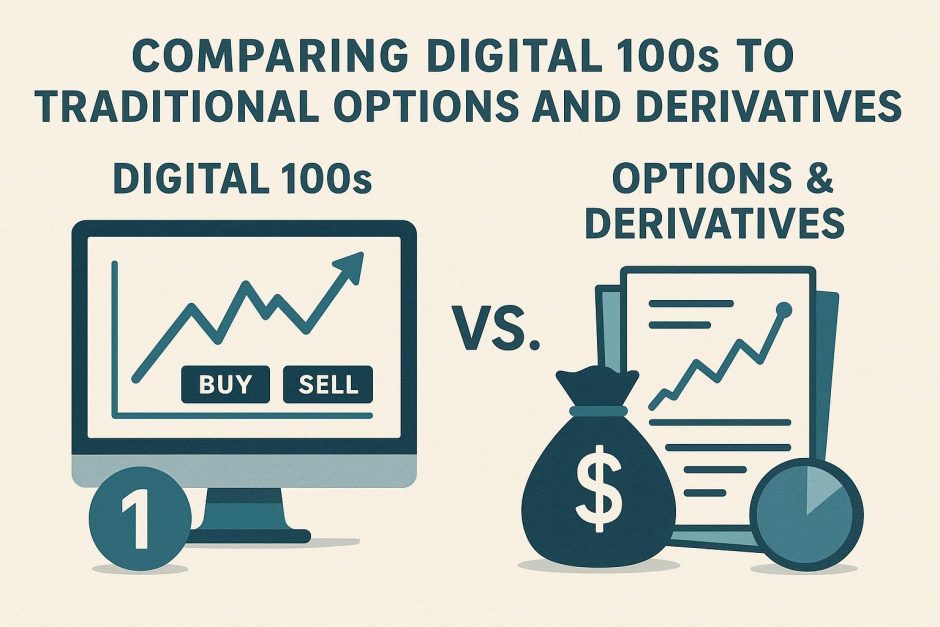Introduction to Digital 100s and Traditional Options
Digital 100s and traditional options are both financial instruments that provide traders with opportunities to speculate on the price movements of various assets. Although they share some similarities, they also have distinct differences that set them apart in terms of risk, potential reward, and the way they function.
Understanding Digital 100s
Digital 100s, often known as binary options, are straightforward financial derivatives with only two possible outcomes: a fixed monetary payout or nothing at all. This all-or-nothing option allows traders to speculate on the price movement of an asset, such as a stock, currency pair, or commodity, within a predetermined timeframe.
Key Characteristics of Digital 100s
The primary appeal of digital 100s is their simplicity. Traders have a clear understanding of the maximum gain or loss possible with each trade because the outcomes are predefined. This makes digital 100s an attractive option for those who appreciate straightforward decision-making and enjoy quick, definitive results in their trading activities.
Moreover, digital 100s typically require a lower capital investment compared to traditional options. This lower entry barrier makes them accessible to a wider range of traders, including those who may not have substantial market experience. It allows individuals to engage in financial markets without committing a large portion of their capital.
However, while the simplicity and limited exposure of digital 100s can be advantageous, their binary nature also implies that the strategic possibilities are somewhat restricted. This aspect means that traders need to be precise in their assessments since even small misjudgments could lead to the loss of the entire investment.
Understanding Traditional Options
Traditional options are financial contracts that give the holder the right, but not the obligation, to buy or sell an underlying asset at a specified price before a certain date. There are two primary types of options: call options and put options.
Call Options give the holder the right to purchase the asset at a predetermined price, which can be advantageous when the market price exceeds the agreed-upon price. On the other hand, Put Options permit the holder to sell the asset at a set price, providing a benefit if the asset’s market value falls below the designated price.
Strategic Opportunities with Traditional Options
The versatility of traditional options is one of their key features. Traders can leverage combinations of calls and puts to craft diverse strategies that cater to various market conditions and risk appetites. This flexibility enables sophisticated approaches to trading, such as spreads, straddles, and collars.
Each strategy requires a thorough understanding of the market forces at play, as well as the potential outcomes of price movements. For example, spreads allow traders to limit potential losses by buying and selling options simultaneously. Meanwhile, straddles let traders profit from significant asset price movements in either direction.
Comparison: Risk and Reward
Both digital 100s and traditional options involve risk, but the nature of this risk can differ significantly.
Risk in Digital 100s: Since digital 100s offer a fixed payout, traders either lose their entire initial investment or gain a predetermined amount. This approach provides clear parameters regarding the risk/reward ratio since the possible outcomes are predefined.
Risk in Traditional Options: Traditional options allow for potentially unlimited profit or losses, depending on the strategy used. The payout largely relies on the price movement of the underlying asset, which adds a layer of complexity compared to digital 100s. The potential for higher rewards with traditional options is significant, but traders must also contend with the possibility of greater risks.
Balancing Risk and Reward
The decision on whether to embrace fixed risk/reward ratios or to engage in potentially unlimited scenarios depends heavily on the individual trader’s risk tolerance. Those who prefer a structured financial environment may find digital 100s more congenial. In contrast, traders eager to explore nuanced trading strategies might opt for the broader horizons of traditional options.
Flexibility and Complexity
Traditional options are generally more flexible and can be part of various complex trading strategies, such as spreads, straddles, and collars. This flexibility allows traders to tailor their approach to different market conditions and risk appetites.
While digital 100s offer a streamlined experience characterized by simplicity and precision, their inherently binary structure curtails some strategic possibilities that are available with traditional options. Thus, traders may find digital 100s beneficial for straightforward engagements but limited when it comes to more elaborate trading plans.
Market Perceptions
Digital 100s have sometimes been viewed with skepticism due to their association with high-risk trading behaviors and the all-or-nothing nature of their payouts. Regulatory bodies in some regions have placed restrictions or bans on these instruments to protect investors from potential misuse.
In contrast, traditional options are regarded as established financial tools. They enjoy a widespread reputation for reliability, being traded on major exchanges worldwide. This provides transparency and liquidity to participants, establishing a sense of trust and stability in the market.
Choosing the Right Instrument
Ultimately, the choice between digital 100s and traditional options depends on an individual’s trading goals, risk tolerance, and understanding of the instruments. Traders seeking simplicity and predefined risk might prefer digital 100s, while those looking to leverage more complex strategies and potential high returns might opt for traditional options.
Traders need to consider their objectives carefully and align their choices with their comfort level with risk and their understanding of these financial instruments. Some may favor the clear and straightforward nature of digital 100s, while others might be drawn to the deeper strategic opportunities offered by traditional options.
For more detailed insights into trading these financial instruments, you may consider reaching out to professional financial advisors or exploring dedicated educational resources offered by trading platforms and financial institutions.









